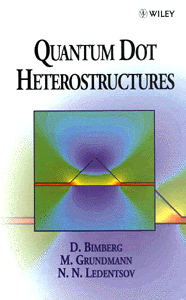
|
Quantum Dot HeterostructuresD. Bimberg, M. Grundmann, N.N. LedentsovInstitute of Solid State Physics, Technische Universität Berlin, Germany Quantum dots are nanometer-size semiconductor structures, and represent one of the most rapidly developing areas of current semiconductor research as increases in speed and decreases in the size of semiconductor devices become more important. They present the utmost challenge to semiconductor technology, rendering possible fascinating novel devices. December 1998, US$ 185 ISBN: 0-471-97388-2 John Wiley & Sons Ltd. Shop at amazon.com bn.com amazon.de |
|
From the contents: Preface 1 Introduction 1.1 Historical development 1.2 Basic requirements for QD's in room temperature devices 2 Fabrication Techniques for Quantum Dots 2.1 Quantum dots fabricated by lithographic techniques 2.2 Quantum dots formed by interface fluctuations 2.3 Self-organized quantum dots 3 Self-Organization Concepts on Crystal Surfaces 3.1 Introduction 3.2 Spontaneous faceting of crystal surfaces 3.3 Periodic arrays of macroscopic step bunches 3.4 Heteroepitaxial growth on corrugated substrates 3.5 Ordered arrays of planar surface domains 3.6 Ordered arrays of three-dimensional coherently strained islands 3.7 Vertically correlated growth of nanostructures 4 Growth and Structural Characterization of Self-organized Quantum Dots 4.1 Introduction 4.2 MBE of InGaAs/GaAs quantum dots 4.3 MOCVD growth of InGaAs/GaAs quantum dots 4.4 Other material systems 4.5 Vertical stacking of quantum dots 4.6 Artificial alignment of quantum dots 5 Modeling of Ideal and Real Quantum Dots 5.1 Strain distribution 5.2 Quantum Confinement 5.3 Coulomb interaction 5.4 Optical Transitions 5.5 Population of levels 5.6 Static external fields 5.7 Phonons 5.8 Quantum dot laser 6 Electronic and Optical Properties 6.1 Etched structures 6.2 Local intermixing of quantum wells 6.3 Stressors 6.4 Selective growth 6.5 Excitons localized in quantum well thickness fluctuations 6.6 Two-fold cleaved edge overgrowth 6.7 Self-organized type-I quantum dots 6.8 Self-organized type-II quantum dots 7 Electrical Properties 7.1 CV spectroscopy 7.2 DLTS 7.3 Vertical tunneling 7.4 Lateral transport 8 Photonic devices 8.1 Photo-current devices 8.2 Quantum dot laser 9 References
|